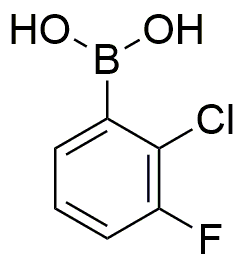(2-Chloro-3-fluorophenyl)boronic acid is widely utilized in research focused on:
- Drug Development: This compound serves as a crucial building block in the synthesis of pharmaceuticals, particularly in the development of targeted cancer therapies. Its unique structure allows for the modification of drug candidates to enhance efficacy and reduce side effects.
- Material Science: It plays a significant role in the creation of advanced materials, such as polymers and nanomaterials. Researchers leverage its boronic acid functionality to develop materials with tailored properties for electronics and sensors.
- Organic Synthesis: In organic chemistry, this compound is used in cross-coupling reactions, such as Suzuki-Miyaura coupling, which is essential for forming carbon-carbon bonds in complex organic molecules.
- Bioconjugation: The ability to form stable bonds with biomolecules makes it valuable in bioconjugation applications, aiding in the development of targeted drug delivery systems and diagnostic tools.
- Agricultural Chemistry: It is also explored in the formulation of agrochemicals, where its properties can enhance the effectiveness of herbicides and pesticides, contributing to more sustainable agricultural practices.
General Information
Properties
Safety and Regulations
Applications
(2-Chloro-3-fluorophenyl)boronic acid is widely utilized in research focused on:
- Drug Development: This compound serves as a crucial building block in the synthesis of pharmaceuticals, particularly in the development of targeted cancer therapies. Its unique structure allows for the modification of drug candidates to enhance efficacy and reduce side effects.
- Material Science: It plays a significant role in the creation of advanced materials, such as polymers and nanomaterials. Researchers leverage its boronic acid functionality to develop materials with tailored properties for electronics and sensors.
- Organic Synthesis: In organic chemistry, this compound is used in cross-coupling reactions, such as Suzuki-Miyaura coupling, which is essential for forming carbon-carbon bonds in complex organic molecules.
- Bioconjugation: The ability to form stable bonds with biomolecules makes it valuable in bioconjugation applications, aiding in the development of targeted drug delivery systems and diagnostic tools.
- Agricultural Chemistry: It is also explored in the formulation of agrochemicals, where its properties can enhance the effectiveness of herbicides and pesticides, contributing to more sustainable agricultural practices.
Documents
Safety Data Sheets (SDS)
The SDS provides comprehensive safety information on handling, storage, and disposal of the product.
Product Specification (PS)
The PS provides a comprehensive breakdown of the product’s properties, including chemical composition, physical state, purity, and storage requirements. It also details acceptable quality ranges and the product's intended applications.
Certificates of Analysis (COA)
Search for Certificates of Analysis (COA) by entering the products Lot Number. Lot and Batch Numbers can be found on a product’s label following the words ‘Lot’ or ‘Batch’.
Numéro de catalogue
Numéro de lot/série
Certificates Of Origin (COO)
This COO confirms the country where the product was manufactured, and also details the materials and components used in it and whether it is derived from natural, synthetic, or other specific sources. This certificate may be required for customs, trade, and regulatory compliance.
Numéro de catalogue
Numéro de lot/série
Safety Data Sheets (SDS)
The SDS provides comprehensive safety information on handling, storage, and disposal of the product.
DownloadProduct Specification (PS)
The PS provides a comprehensive breakdown of the product’s properties, including chemical composition, physical state, purity, and storage requirements. It also details acceptable quality ranges and the product's intended applications.
DownloadCertificates of Analysis (COA)
Search for Certificates of Analysis (COA) by entering the products Lot Number. Lot and Batch Numbers can be found on a product’s label following the words ‘Lot’ or ‘Batch’.
Numéro de catalogue
Numéro de lot/série
Certificates Of Origin (COO)
This COO confirms the country where the product was manufactured, and also details the materials and components used in it and whether it is derived from natural, synthetic, or other specific sources. This certificate may be required for customs, trade, and regulatory compliance.


